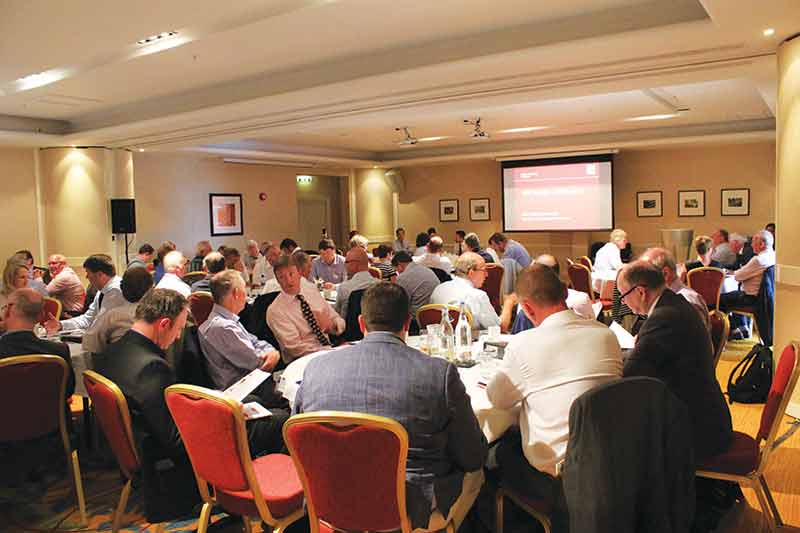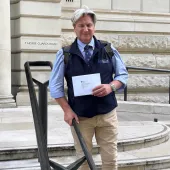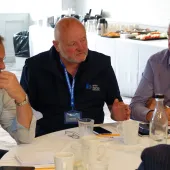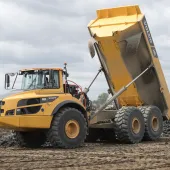British Aggregates Association’s 2015 Conference Report

First published in the August 2015 issue of Quarry Management as Lessons to be Learned
QM reports on the British Aggregates Association’s 2015 seminar proceedings
This year’s British Aggregates Association Conference proved to be yet another success with more than 100 delegates attending the annual event, which was held at the Forest of Arden Marriot Hotel and Country Club, in Birmingham, on Monday 29 June.
The day began with a morning session chaired by long-serving BAA secretary Peter Huxtable and comprising six short ‘cameo’ presentations on a wide variety of themes, ranging from archaeological planning and collating UK mineral statistics to maximizing quarry reserves by applying pre-split blasting techniques.
The opening presentation was given by Jo Mankelow, team leader for mineral resources and policy at the British Geological Survey, who highlighted the importance of undertaking aggregate minerals surveys to collect and collate key data for the benefit of the industry. Using the aggregate minerals survey 2014 as a prime example, he gave an insight into the organization’s systematic approach to managing collected and collated data in two separate surveys, and went on to explain how results become a key source of data for developing and monitoring policy for primary aggregates provision in England and Wales.
Next to take the floor was Hugh Carson of the Ecton Mine Educational Trust, who gave an enthralling talk on the historic Ecton mining area in the Peak District National Park. With the copper mine recognized as a Site of Special Scientific Interest (SSSI) and valuable education resource, Mr Carson spoke about the Trust’s principal aim of promoting education in geology, mining and mineral extraction, and ensuring Ecton remains an accessible study centre for biodiversity and long-term mineral site restoration.
One of the Trust’s key tasks that underpins these efforts, he said, is providing the necessary resources/facilities for schools and universities to run field courses, which introduces young people to subjects relevant to the mineral products industry. This is particularly important at a time when there is an ageing workforce on the horizon for the sector and the need to attract the next generation of talented and skilled people hits home.
Moving on to another important topic, Mike Young, head of land and mineral resources for Hope Construction Materials, discussed the pros and cons of the current Mineral Extraction and Archaeology practical guidance (published in 2008). While the guide provides a question-led and
cost-effective approach to planning, and identifies the most appropriate techniques in archaeology, he pointed out a number of flaws in the document and urged the industry to review and update the guidance to include, for example, sustainable development and National Planning Policy Framework references.
Next to speak was Brian Duthie, director of Key GeoSolutions, who gave a detailed talk on how pre-split blasting techniques can help maximize quarry reserves without comprising safety or the environment. He highlighted the findings of a limestone quarry (used as a case study) to provide a better understanding of the technical methods adopted and how they improved the face condition, alignment and geometry.
Mr Duthie concluded that once these objectives are met, many operators can look forward to increased reserves thanks to a steeper overall slope and reduced bench widths. From a safety perspective, companies will also benefit from reduced maintenance and the lower risk of rockfall.
Richard Lashmore, head of mines and minerals at Knights, spoke about the Mining Code as a statutory scheme regulating the working of minerals under and in the vicinity of undertakings (eg railways, water/sewage pipes, roads etc.). He reminded BAA delegates of the different versions of the Code contained in Acts, such as the Acquisition of Land Act 1981 and Water Industry Act 1991. Mr Lashmore also highlighted some interesting issues in relation to the Mining Code, but the underlying message of his presentation, as he emphasized, was that it was not so much a code – more a set of guidelines.
In the final cameo presentation of the morning, Caz Jewell, programme manager for Nature After Minerals (NAM), provided a quick update on the final stages of the EU-funded RESTORE programme. A fundamental part of the project has seen NAM working closely with the Royal Society for the Protection of Birds (RSPB), along with other partner organizations, to develop a framework to restore quarries for the benefit of people, biodiversity and habitats across north-west Europe.
She outlined some of the key challenges on the three-year programme and emphasized the importance of following the project’s 10 guiding principles in restoration with reference to a number of relevant case studies in Europe and within RESTORE partner countries. With the RESTORE project drawing to a close, she said the dissemination of results will be key to driving forward the quality of restoration plans, inspiring and promoting further case study examples of good practice.
The morning session was rounded off by Eric Darlow, chair of the BAA’s Standards and Awards Panel, who spoke about the importance of continuously delivering a safer, more visible and healthier quarry workplace for employees.
He outlined some of the major benefits of the Association’s assessment scheme and on the question of encouraging new BAA members and easing the costs for existing members, he reassured everyone the Awards Committee is still considering how best to manage multi-site assessments rather than implementing costs of a separate assessment for every site.
Mr Darlow added he was pleased with the progress made on the BAA and HSE’s ‘Interventions Review’ scheme and announced the site inspection trial has been extended to another 12 months, with further volunteer sites earmarked within the BAA’s Assessment Scheme as well as sites not in the standards programme. However, at the same time he expressed his disappointment at some of the recent inspection findings, including lack of elevated road edge protection and most discrediting of all – machinery guarding.
On a brighter note, Mr Darlow praised those members for their participation in the BAA operating competence scheme and this year’s compliance certificates were awarded to William Thompson and Son’s Sheephill Quarry, in Dumbarton; Sherburn Stone Company’s Helbeck Quarry, in Kirkby Stephen; and Longcliffe Quarries’ Bone Mill site, in Hopton, and Brassington Moor Quarry, in Matlock.
Marking a first for the BAA, a new prestigious health and safety award (in the form of a celebratory shield plaque) was introduced at the ceremony and the first recipient of the Association’s Assessment Scheme Quarry of the Year Award 2015 was Helbeck Quarry.
Congratulating the winners, Sherburn Stone Co., Mr Darlow said the progress and reward in the pursuit of health and safety in the workplace was always good reportable news and that the BAA has a long-standing tradition of recognizing its members for their achievements – and this new award will hopefully encourage more companies to engage with workforce competence and training initiatives.
Continuing the theme of health safety best practice, the afternoon seminar session commenced with a presentation by Roy Bush, HM Inspector of Quarries, who gave an update on the health and safety performance across the quarrying industry. While the industry has made significant progress towards the Target Zero campaign, the current objective to reduce accidents by 15% year-on-year (up to 2015 from 2010 baseline), he argued, had disappointingly not seen much improvement.
As a wake-up call for industry, Mr Bush reminded everyone of the importance of competence and ongoing training, and identified a need for increased worker involvement and collaborative working between managers and employees on key safety issues.
In the second part of the presentation, HSE Quarry Inspector Cath Pickett provided another review of the BAA and HSE Interventions initiative. Over the last 12 months, a total of 19 BAA sites had been visited and the inspections on the volunteer quarries (participants on the Assessment Scheme) and non-volunteer sites (not on the Scheme), once again, found inadequate machinery guarding to be the most common infringement – similar to last year’s findings.
Next to take the floor was Adrian Wilkinson, geotechnical director of Quarry Design, who highlighted the safety and cost-saving benefits to be gained from remote surveying and geological mapping in the quarry environment using unmanned aerial vehicles (UAVs).
He explained the current drone laws in the UK, different UAV systems and payloads, training and flight planning methodology required to operate UAVs in quarries. Using case studies from Quarry Design’s geotechnical portfolio, he showed how remote data survey methods can eliminate the need for workers to be exposed to safety hazards associated with quarry faces, lagoons, haul roads and moving vehicles or plant.
The penultimate speaker of the day was law firm No. 5 Chambers’ Adrian Keeling QC, who offered some useful information on what to do when, for example, an executive director is called in for questioning/interview by the police. He began by outlining the written codes governing a person’s rights during the interview stage and urged anyone in this situation to have legal representation lined up as early possible.
In a joint presentation, Phil James (executive director), Julian Smallshaw (head of education development) and Emma Bellingham (professional development officer) from the Institute of Quarrying (IQ) spoke about the challenges and opportunities ahead for the forward-thinking organization.
Mr James began by focusing on the exciting new developments and major growth areas for the IQ. High on his agenda, he said, was to achieve further growth internationally, ensuring the IQ brand and its members are synonymous with professional competence and excellence around the world. He also touched upon many wide-ranging issues including, among others, the organization’s centenary planning for 2017, IQ membership cards, a new strategic business plan, the ongoing success of PRIME and a new, free CPD app being developed for members.
Ms Bellingham reiterated the importance of ongoing professional development in the workplace and explained the need for individuals to maintain competence through continuing professional development. She also gave a brief insight into a new ‘student membership’ that IQ is currently developing which will bring benefits to young people joining the industry.
Finally, Mr Smallshaw discussed the benefits of the Institute’s blended training programme, including the successful launch of the IQ qualification Level 3 Award in Health, Safety and Environmental Awareness. He added that the Institute was now looking to develop further Level 3 training qualifications encompassing a variety of roles in the quarrying sector.
He also provided an update on the IQ’s overseas education strategy, focusing in particular on the delivery of training sessions to quarry operators in Dubai and other parts of the United Arab Emirates. And looking further ahead, he confirmed that the IQ and National Stone, Sand and Gravel Association (NSSGA) are currently in advanced discussions to work in partnership and possibly launch a pilot training programme in the US, which, Mr Smallshaw said, could be a real ‘game changer’ for the Institute.
- Subscribe to Quarry Management, the monthly journal for the mineral products industry, to read articles before they appear on Agg-Net.com








